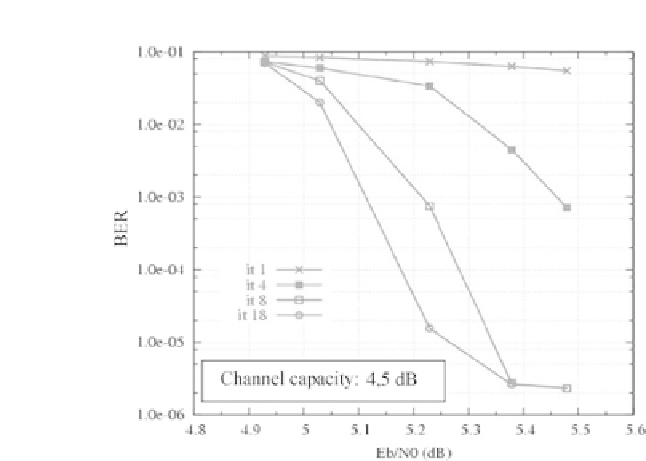Cryptography Reference
In-Depth Information
Figure 10.4 - BER as a function of the signal to noise ratio E
b
/N
0
of the 16-QAM
TTCM with 8 states using the RSC code of Figure 10.2(b). Transmission over a
Gaussian channel. Spectral eciency
η
=3
bit/s/Hz. Blocks of 15,000 information
bits, 5,000 modulated symbols. MAP decoding algorithm. Curves taken from [10.6].
10.2
Pragmatic turbo coded modulation
The so-called
pragmatic
approach was chronologically the first implementation.
It was introduced by Le Goff
et al
. [10.4] in 1994. This technique takes its
name from its similarities with the technique of associating a convolutional
code and modulation proposed by Viterbi [10.2] as an alternative solution to
Ungerboeck's TCMs. The coding and modulation functions are processed in-
dependently, without joint optimization. It uses a "good" turbo code, a bit to
signal mapping which minimizes the probability of binary error at the output
of the corresponding demapper (Gray coding) and associates the two functions
via puncturing and multiplexing to adapt the whole scheme to the spectral ef-
ficiency targeted. Figures 10.9 and 10.10 present the general diagram for the
principle of the transmitter and the receiver for the pragmatic association of a
turbo code and modulation with
Q
=2
q
states.
With this pragmatic approach to turbo coded modulation, the encoder and
the decoder used are standard turbo encoders and decoders, identical for all
coding rates and modulations considered. If the size of the blocks of data trans-
mitted is variable, simple parametering of the code's permutation function must
allow it to adapt to different sizes.
When the targeted coding rate is higher than the natural rate of the turbo
code, the puncturing operation enables it to erase, that is to say, not transmit,



